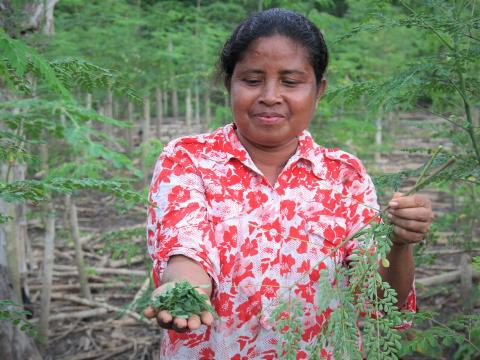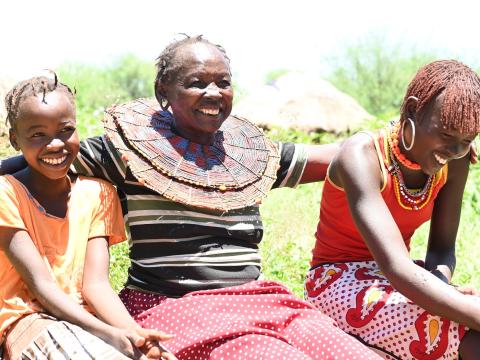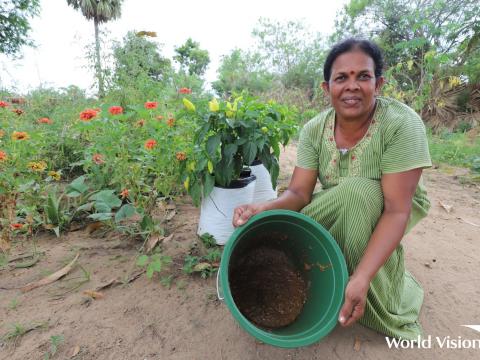
Gender equity: a key to ending malnutrition
Melani O'Leary is Health Technical Specialist at World Vision
Two years into a global pandemic and COVID-19 has unleashed a global malnutrition crisis whose primary victims are women and girls. That is why the Nutrition for Growth Summit couldn’t come at a better time.
At the heart of this crisis is an existing gender equality chasm that the pandemic is exacerbating. Even before the pandemic, women and girls were more likely to be malnourished, making up 60 per cent of the world’s people living with chronic hunger. Now women are leaving the workforce in significant numbers. They’re shouldering the burden of domestic care responsibilities, suffering serious mental health challenges, and facing alarming increases in sexual and gender-based violence.
Conflict and climate change are also disproportionately hurting women and girls, multiplying the impact on malnutrition, and reversing years of hard-won gains in our fight for gender equality.
When it comes to nutrition, the projections for women and girls are alarming. It is now predicted that an additional 4.8 million women will suffer from anaemia, on top of the 1 billion women and girls who are currently affected. The gender gap in the prevalence of food insecurity continues to grow – in 2020 it was 10% higher among women than men, compared to 6% in 2019.
Across the world, and particularly the Global South, women are continually denied a voice and decision-making rights regarding what and when they eat, where and when they go to seek health care, and if and when to have children. In short, women have less agency than men.
And this right is vitally important to women and girls' nutrition. The devastating impacts of malnutrition, combined with increases in sexual and gender-based violence, are changing the trajectories of their lives forever; often including unplanned pregnancies that wreak havoc on young bodies and perpetuate cycles of malnutrition, poverty and inequality.
These injustices are rooted in systemic barriers to equity and empowerment – and the ripple effect extends across many facets of women and girls’ lives, restricting livelihood, education, and growth opportunities. These effects stifle their agency and limit their access to and control over the resources required to meet their unique nutrition needs.
Amidst this challenging global context, nutrition must be treated as a gender equality issue. Achieving gender equality will not be possible as long as women and girls suffer from malnutrition at a much higher rate than men and boys. This calls for new actions that consider specifically how to address the unique challenges faced by women and girls.
We know that investing in nutrition offers one of the best returns on investments: for every $1 invested in nutrition, $16 is returned to the local economy. But the return on investment we see when those investments are made in a gender-transformative way is even greater. Ensuring that girls are well-nourished means that they can stay in school longer, perform better in school, and participate more equitably in the economy. This translates into more decision-making power over their nutrition and reproductive choices and their futures overall, thereby helping to break intergenerational cycles of malnutrition.
Here the evidence is clear. If women had the same access to productive resources as men, their agricultural yields would increase by 20 to 30 per cent and total agricultural output by 2.5 to 4 per cent. This would lift between 100 and 150 million people out of hunger.
If primary schooling for girls in Sub-Saharan Africa was universal, agricultural productivity would increase by 25% and if women in low and lower middle-income countries finish secondary school, the number of children too short for their age, or stunted, would decrease by 26%.
Given that these same types of gender equality investments have similar effects across all Sustainable Development Goals, what more evidence is needed for action? It is both a moral imperative and the best return on investment we can make.
In other words, gender equality is as close as we get to a proverbial silver bullet in development.
It is time to be serious about addressing the systemic gender inequalities that women and girls face around the world. We need to move away from addressing the symptoms of gender inequality and tackle the root causes head on. This means that we need to focus on transforming the unequal power dynamics and structures that reinforce gender inequality. This is an ambitious objective, but it’s the only way to create the transformational change that is needed to advance the rights of women and girls and ensure their nutritional wellbeing.
True change will only happen when women and girls are able to exercise their own agency over strategic life decisions, have access to and control over resources, and can depend on an environment around them that champions their right to good nutrition. It means holding governments accountable to put in place policies that support women and girls to claim their rights, and it requires that men and other traditional power holders stand up and use their positions of power and influence to shape systems to create a more equitable world for all.
By placing gender equality at the centre of the interventions to address malnutrition, we can transform the multiple systems and structures that perpetuate gender inequality and malnutrition, and pave the way to sustainably improve nutrition and access to affordable, healthy diets for all.
Read more about what this looks like in detail: Gender-Transformative Framework for Nutrition
Melani O’Leary is World Vision Canada’s Health Technical Specialist. Follow Melani on Twitter @WorldVisionMel and LinkedIn www.linkedin.com/in/olearymel


